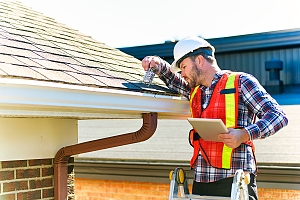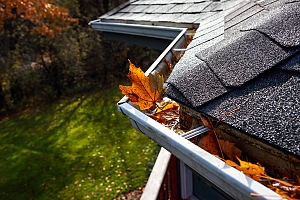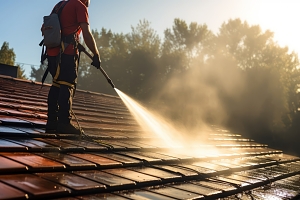Your roof is one of the most critical components of your home, providing protection from the elements and maintaining the structural integrity of your property. However, without proper maintenance, your roof can deteriorate over time, leading to costly repairs and potential damage to your home’s interior.
In this blog post, we’ll explore essential roof maintenance tips to help you preserve your investment and ensure the longevity of your roof.
Regular Inspection: Identifying Issues Early
 Conducting routine inspections of your roof stands as a cornerstone of responsible homeownership, offering a proactive approach to preserving the integrity and longevity of your property. These regular assessments serve as a vital line of defense against the potential onslaught of costly and disruptive roofing issues, allowing you to nip problems in the bud before they spiral out of control.
Conducting routine inspections of your roof stands as a cornerstone of responsible homeownership, offering a proactive approach to preserving the integrity and longevity of your property. These regular assessments serve as a vital line of defense against the potential onslaught of costly and disruptive roofing issues, allowing you to nip problems in the bud before they spiral out of control.
Committing to a biannual inspection schedule ensures that your roof receives the attention it deserves throughout the changing seasons. By dedicating time to scrutinize the condition of your roofing system at least twice a year, you gain invaluable insights into its overall health and identify any red flags that may signal impending trouble.
During these inspections, it’s imperative to conduct a thorough examination of key components, including the shingles, flashing, and gutters. Begin by visually inspecting the surface of your roof, paying close attention to the condition of the shingles. Look for signs of damage such as cracks, curling, or missing pieces, which can compromise the roof’s ability to provide adequate protection against the elements.
Next, focus on the flashing—the metal strips installed around roof penetrations such as chimneys, vents, and skylights. Inspect these areas carefully for signs of corrosion, rust, or loosening, as damaged flashing can allow water to seep into your home, leading to leaks and structural damage.
Finally, direct your attention to the gutters and downspouts, which play a crucial role in channeling water away from your roof and foundation. Clear any debris or obstructions that may impede proper drainage, as clogged gutters can cause water to accumulate on your roof, increasing the risk of leaks and water damage.
Should you encounter any signs of damage or wear and tear during your inspection, it’s imperative to address them promptly to prevent further deterioration. Whether it involves replacing damaged shingles, repairing compromised flashing, or clearing debris from gutters, taking proactive measures can save you from the headache and expense of more extensive repairs down the line.
Clearing Debris: Preventing Damage and Water Build-Up
 Maintaining a clean and debris-free roof is essential for preserving its structural integrity and safeguarding your home against water damage. Leaves, branches, and other debris have a knack for finding their way onto your roof, where they can accumulate over time, creating a breeding ground for potential problems. To mitigate these risks, it’s crucial to prioritize regular maintenance and clearing of debris to uphold the health and longevity of your roofing system.
Maintaining a clean and debris-free roof is essential for preserving its structural integrity and safeguarding your home against water damage. Leaves, branches, and other debris have a knack for finding their way onto your roof, where they can accumulate over time, creating a breeding ground for potential problems. To mitigate these risks, it’s crucial to prioritize regular maintenance and clearing of debris to uphold the health and longevity of your roofing system.
Leaves, carried by the wind or shed from nearby trees, often settle on the surface of your roof, forming a thick layer that traps moisture and encourages the growth of mold and mildew. Additionally, branches and twigs may become lodged in crevices or gutters, obstructing the flow of water and impeding proper drainage. Left unchecked, this accumulation of debris can lead to water build-up, which can seep into your home, causing damage to ceilings, walls, and insulation.
To prevent these potential hazards, make it a habit to regularly clear debris from your roof and gutters. Begin by visually inspecting your roof for any signs of accumulation, paying close attention to valleys, ridges, and areas around chimneys and skylights where debris tends to accumulate. Use a sturdy ladder and a leaf blower, broom, or rake to safely remove leaves, branches, and other debris from the surface of your roof, taking care not to damage the shingles or flashing in the process.
Next, turn your attention to the gutters and downspouts, which play a crucial role in channeling water away from your roof and foundation. Remove any leaves, twigs, or other obstructions that may be blocking the flow of water, ensuring that gutters are free-flowing and unimpeded. Consider installing gutter guards or screens to minimize the accumulation of debris and facilitate easier maintenance in the future.
By keeping your roof free of debris, you not only reduce the risk of water damage but also prolong the lifespan of your roofing system.
Regular maintenance and clearing of debris help to maintain proper drainage, preventing water build-up and minimizing the potential for leaks and structural damage. Additionally, a clean and well-maintained roof enhances the overall aesthetic appeal of your home, contributing to its curb appeal and value.
Repairing Damage Promptly: Addressing Issues Before They Worsen
Don’t ignore signs of roof damage such as leaks, missing shingles, or sagging. Addressing these issues promptly can prevent further damage to your roof and your home’s interior. While some repairs can be tackled as DIY projects, it’s essential to know when to call a professional roofing contractor for assistance.
Maintaining Proper Ventilation: Preventing Moisture Build-Up
Proper roof ventilation is essential for controlling moisture and preventing mold and mildew growth. Ensure your roof has adequate ventilation to allow for airflow and reduce moisture build-up. If you notice signs of poor ventilation, such as condensation or musty odors in your attic, take steps to address the issue promptly.
Trim Overhanging Branches: Preventing Damage from Trees
Overhanging branches can pose a risk to your roof, causing damage to shingles and gutters. Trim back branches that hang over your roof to prevent potential damage and reduce the risk of falling debris during storms. Consider hiring a professional arborist for tree trimming to ensure safety and proper care for your trees.
Cleaning Moss and Algae: Preserving Roof Health
 Moss and algae growth on your roof can compromise its integrity and detract from its appearance. Safely remove moss and algae from your shingles using appropriate cleaning methods. Taking preventative measures, such as installing zinc or copper strips, can help minimize future growth and preserve the health of your roof.
Moss and algae growth on your roof can compromise its integrity and detract from its appearance. Safely remove moss and algae from your shingles using appropriate cleaning methods. Taking preventative measures, such as installing zinc or copper strips, can help minimize future growth and preserve the health of your roof.
Professional Maintenance: Investing in Long-Term Roof Health
Consider hiring a professional roofing contractor for periodic maintenance to ensure your roof remains in optimal condition. Professional services such as inspections, repairs, and maintenance can extend the lifespan of your roof and save you money in the long run.
Schedule Your Roof Maintenance with Dirt Connections
Proper roof maintenance is essential for preserving the integrity and longevity of your home. By following these roof maintenance tips and investing in professional maintenance services, you can ensure your roof remains in top condition and continues to protect your home for years to come.
Don’t wait until it’s too late—prioritize roof maintenance today and enjoy peace of mind knowing your investment is well-protected.Our experienced team will inspect, repair, and maintain your roof to keep it in optimal condition for years to come. Don’t wait until it’s too late—schedule your roof maintenance with Dirt Connections today and protect your investment for the future.








































